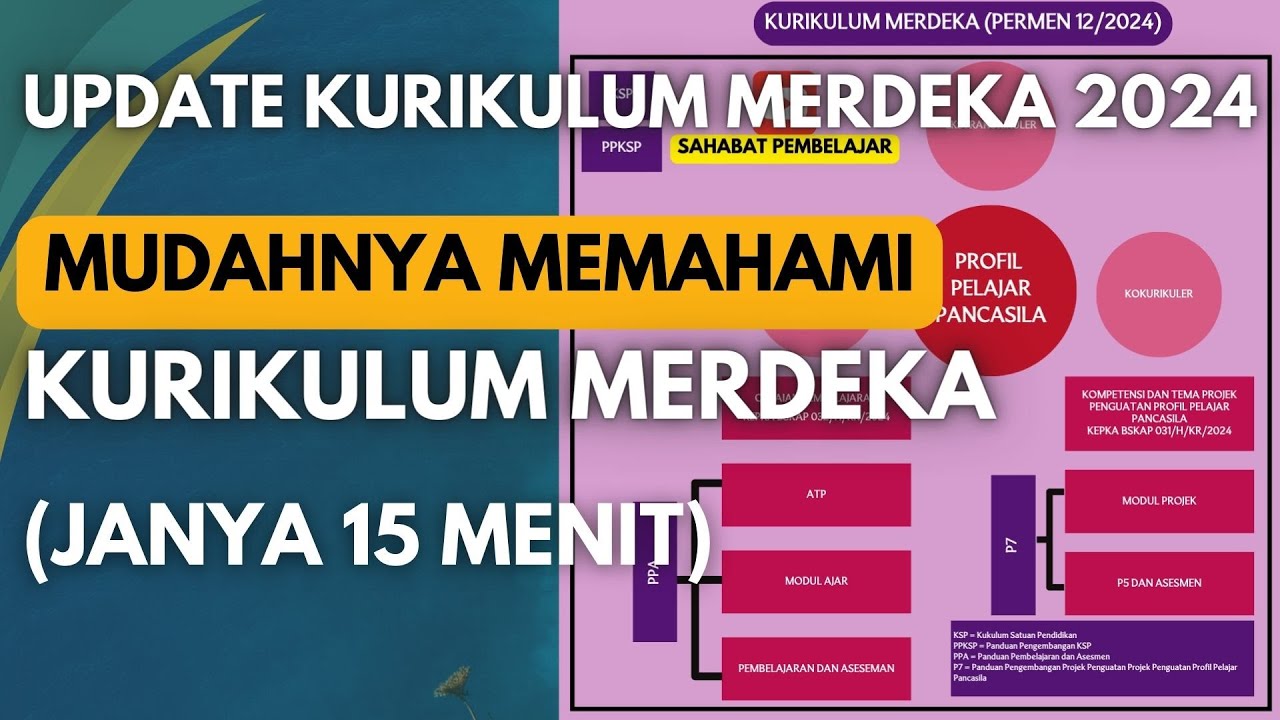Video 5 : Petunjuk teknis menguraikan CP dengan metode 3
Summary
TLDRThis video continues the discussion on breaking down Competency Standards (CP) into Learning Objectives (TP) and Advanced Learning Objectives (ATP) using a third method. The presenter explains how to integrate different subject elements, using examples from math and physics. The third method involves cross-element integration, which helps create more varied and comprehensive learning objectives by combining knowledge and skill components. The presenter also emphasizes the importance of aligning learning objectives with subject characteristics, student skills, and the overall curriculum structure for effective teaching.
Takeaways
- 📚 The video is a continuation of a series on converting CP (Competency Achievement) into TP (Learning Objectives) and ATP (Learning Assessment) using the third method.
- 🔍 The third method involves combining elements across different subjects or topics to form comprehensive learning objectives.
- ✏️ In mathematics, elements like geometry, measurement, and algebra can be combined to create broader learning goals, such as measuring geometric shapes while understanding unit conversions.
- ⚛️ Physics has two key elements: understanding physics concepts and process skills, such as thinking skills, which differentiate it from subjects like math.
- 📝 The process begins by selecting a topic from physics (e.g., fluid mechanics) and pairing it with a relevant process skill, like investigation and experimentation.
- 🔧 Teachers can design higher-level learning objectives by combining knowledge-based content with process skills, such as conducting experiments or analyzing data.
- 🧪 An example learning objective is for students to design and experiment with a ship that can carry maximum weight, combining fluid mechanics and investigation skills.
- 🎯 The focus is on ensuring that learning objectives are more comprehensive and tied to real-world applications, increasing engagement through hands-on activities.
- 🗂️ Each subject has unique elements; for instance, language subjects are more skill-based, like reading and listening, and should be tailored accordingly.
- 📈 Teachers must ensure that the learning objectives are practical, aligned with the curriculum, and progress linearly from the beginning to the end of each phase.
Q & A
What is the third method for formulating learning objectives (TP) in the video?
-The third method for formulating learning objectives (TP) is cross-element formulation within a curriculum (CP). This method allows combining elements from different topics, such as geometry and measurement in mathematics, to create a more comprehensive learning objective.
How is the third method different from the first two methods discussed in previous videos?
-The third method focuses on formulating learning objectives by combining different elements across subjects, such as combining geometry and measurement in mathematics, while the first two methods involve more straightforward formulations from specific elements within one subject.
What are the two elements in the Physics curriculum mentioned in the video?
-The two elements in the Physics curriculum are: 1) Physics understanding, which focuses on theoretical knowledge, and 2) Process skills, which involve practical applications and thinking skills.
How does the video suggest combining the two elements in Physics for a comprehensive learning objective?
-The video suggests selecting a topic from the Physics understanding element, such as 'fluids,' and pairing it with a process skill, like 'planning and conducting an investigation,' to create a comprehensive learning objective, such as designing an experiment to study a ship's load-carrying capacity.
Can you give an example of how a cross-element objective could be formed in Physics?
-An example is combining the fluid mechanics topic with the process skill of designing and conducting investigations. A learning objective could be: 'Students can design and conduct an experiment on how different ship designs can maximize load-carrying capacity.'
How does this method improve learning objectives compared to traditional methods?
-This method allows for more complex and hands-on learning objectives that go beyond theoretical knowledge. By incorporating practical skills, students can engage in activities that promote higher-level cognitive processes, such as problem-solving and experimentation.
What is the importance of combining elements in subjects like Mathematics, according to the video?
-Combining elements allows students to apply their knowledge in different contexts, such as using measurement skills within a geometry problem. This helps create a more integrated understanding of the subject and promotes critical thinking.
What challenges might arise when formulating learning objectives across elements?
-One challenge is ensuring that the learning objectives remain aligned with the main competencies outlined in the curriculum. Additionally, teachers must balance different elements without overwhelming students or exceeding the allocated teaching hours.
How does the video recommend ensuring learning objectives are operational and effective in the classroom?
-The video recommends formulating learning objectives that are specific, measurable, and applicable in real classroom settings. It also suggests considering students' characteristics to select appropriate teaching methods.
What is the key takeaway for teachers from the video regarding cross-element learning objectives?
-The key takeaway is that cross-element learning objectives can enrich students' learning experience by combining knowledge and skills across topics. Teachers should ensure that these objectives are clear, achievable, and enhance both theoretical and practical understanding.
Outlines

This section is available to paid users only. Please upgrade to access this part.
Upgrade NowMindmap

This section is available to paid users only. Please upgrade to access this part.
Upgrade NowKeywords

This section is available to paid users only. Please upgrade to access this part.
Upgrade NowHighlights

This section is available to paid users only. Please upgrade to access this part.
Upgrade NowTranscripts

This section is available to paid users only. Please upgrade to access this part.
Upgrade NowBrowse More Related Video

Video 3 : Petunjuk Teknis Menguraikan CP dengan Metode 1

Video 4 : Petunjuk Teknis Menguraikan CP dengan Metode 2

Cara Cepat Membuat TP & ATP Informatika Fase D Berdasarkan Perubahan CP Terbaru 2024 yang Tepat !!!

MUDAHNYA MEMAHAMI KURIKULUM MERDEKA. CUKUP 15 MENIT. UPDATE KURIKULUM MERDEKA 2024

Unpacking Standards

Panduan Cara Menyususn ATP (Alur Tujuan Pembelajaran) Kurikulum Merdeka. Format ATP
5.0 / 5 (0 votes)